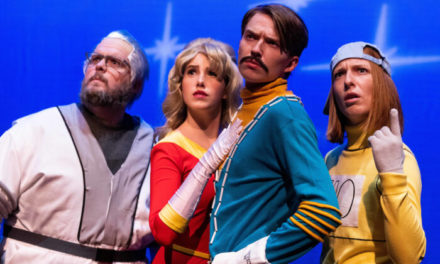PROVO — Nearly every theatre company has done Shakespeare. I’ve seen more high-concept, modernized, stripped-down, period-swapping, gender-bending shows than I can count. And it’s scientific fact that a new production of Hamlet is mounted every 30 seconds. (Read: no, it isn’t.) So how to make a 500-year-old play that’s been done to death fresh and entertaining? Actors from the London Stage took away the high concept, the director, the sets, the lights, most of the props, and all but five actors in their clever, refreshing, rip-roaring production of Much Ado About Nothing.
Much Ado is a comedy about Beatrice and Benedick, two people seemingly incapable of love. Newly engaged couple Hero and Claudio team up with Leonato—Hero’s father—and Don Pedro—the prince—in a conspiracy to get Beatrice and Benedick to fall in love. All the while Don John, Don Pedro’s illegitimate brother, schemes against the happy couple.
Thanks to local theatre troupe Grassroots Shakespeare Company, we Utahns are no strangers to the minimalist approach to the Bard. But for those of you who are unfamiliar with the convention or who are curious about how anyone could pull it off, here’s how it goes: Each actor plays five or six characters. The company assigns a specific prop or costume piece to each character. In the scenes where an actor plays more than one character, the other actors use the costume pieces or props as placeholders and interact with them as if they were the other character. For example, Claire Redcliffe played Hero and Leonato. Hero held a flower, and Leonato wore a hat. In my favorite use of the convention, the entire company was gathered around Hero as she prepped for the masque. Redcliffe slipped back and forth from Hero to Leonato while the other actors held the hat and the flower in the air. While this convention could be gimmicky or end up confusing the audience, it was so well employed that I had no trouble understanding who the characters were and how they related to each other. It certainly helps that there was a rapid-fire review at the beginning of the show where the company introduced everybody. (“Leonato, a wealthy man, and Hero, his daughter. Beatrice, an orphan, his niece,” etc.)
Al Barclay’s messenger started the play on the right foot, putting in the mood to laugh and effortlessly introduced the character switching. His Don Pedro was affable, his Friar Francis was kindly and wise, his watchman was absolutely hysterical, and his Ursula was ridiculous. He tied with Georgina Strawson for most characters played, and pulled off each in an impressive theatrical feat. Strawson played Beatrice, Don John, Balthasar, Verges, and a boy. While I didn’t like her Beatrice in the first couple of scenes, by the time she professed her love for Benedick, she had become one of my favorite Beatrices I’ve seen. She was quick-witted without being mean-spirited, dimensional and complex, and when she screamed, “I love you with so much of my heart that none is left to protest!” it was such a defining moment that I thought the play could have ended right then and there and I would have been happy.
Jack Whitam played Claudio, Borachio, Antonio, and Margaret. There was a beautiful kind of subtlety to Whitam’s performance that separated his characters from each other and gave depth to each of them in turn. One of his best moments was when Borachio was defending Margaret’s innocence to Leonato and the watch. He was unexpectedly so sincere—more sincere than I have ever seen a Borachio be. Redcliffe’s Hero was sweet without being vapid, and her Leonato was warm. It is unfortunate that the least effective character-swap was at the wedding. Previously the character-swap had been used to great comedic effect, so when it occurred in this tense moment there was some uncomfortable laughter when Hero, unconscious in Beatrice’s arms, stood up and became Leonato. This, sadly, overshadowed Redcliffe’s lovely performance.
Paul O’Mahony’s Benedick was smooth, intelligent, and likable. He interacted with Beatrice, Don Pedro, and Claudio so naturally that it seemed as if he had been doing it for years. O’Mahony’s Dogberry was fantastic, and some of the best character transitions in the show came from his Dogberry/Conrade scenes. O’Mahoney was charismatic, and I found I couldn’t take my eyes off him whenever he had command of the stage, yet he never upstaged the other actors. In fact, the entire company was complementary. They worked so well together; they shared the stage, and they took each other’s little mistakes in stride, covering them amiably.
In the absence of any sort of concept, and in the hands of very capable actors, the strengths of Shakespeare’s script were obvious. I finally understood Don John’s determination to disgrace Claudio and embarrass Don Pedro, and why the friar felt the need to pretend Hero was dead. The plot was easy to follow, the language was clear and understandable, and almost all of the jokes were successful. Granted, there were a few missteps: the Hero/Ursula/Beatrice scene in the garden was labored—what exactly could the characters see? How high were those hedges? And the first scene with Don John and Conrad escalated too quickly, so the actors were just in each other’s faces for about two minutes. Nevertheless, the production as a whole was immensely successful. I laughed so hard I cried, I got the chills, and I just had a really good time. If you manage to secure tickets to this limited run, you can count yourself lucky; productions like this don’t happen every day. And in a Shakespeare-saturated world, that’s saying something.
NOTE: If you’re seeing the show in the courtyard, bring something to sit on. Those bleachers can be killer. Don’t understand Shakespeare? No problem! There’s a handy plot summary in the program, and the actors use hand gestures to make the words more accessible. This production is suitable for children who can sit through a two-hour-long show.








